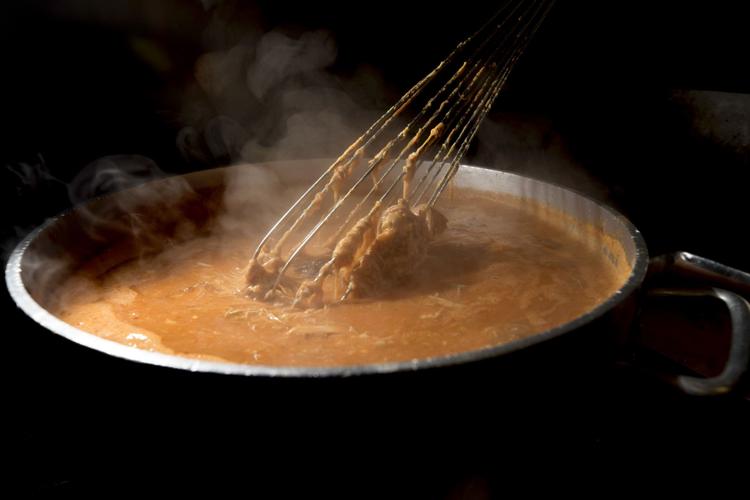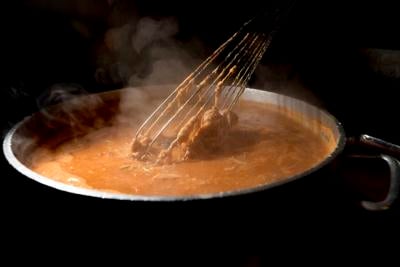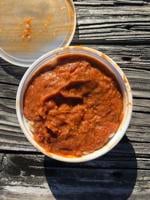The Post and Courier reviewed every barbecue hash sold between I-95 and the coast. Read up on all 28 hashes here.
Whole-hog maestro Rodney Scott had already opened locations of Rodney Scott’s BBQ in Charleston and Birmingham, Ala., when he revealed to a reporter in Atlanta that he’d like to sell barbecue all over the world. A true evangelist for the Pee Dee cooking style, the James Beard award winner dreams of anointing foreign lands with peppered vinegar.
It’s not a wholly surprising ambition. Scott’s commitment to disseminating South Carolina customs drives the menu he replicates wherever he goes.
As he put it in the Atlanta Magazine interview, promoting a restaurant he’s opening there in April, “My food is my life growing up. … It’s all based on the flavors I remember as a child.” That’s why the catfish is fried, the cornbread is sweet and the greens are cooked with lard.
But one of the state’s most cherished barbecue traditions is conspicuously absent from the Rodney Scott’s sides section. Amid the hush puppies and potato salad and greens, there’s no mention of hash.
“We had hash years ago in Hemingway,” Scott says of the convenience store and barbecue takeout his parents, Rosie and Ella, in 1972 opened in Williamsburg County. “My mom made it. She was doing it with like all the bits and pieces and stewing it, so to speak. Man that was so much work. But growing up where I did, most of the talk was hash-and-rice.”

A variety of spices will be added to the pot as Nigel Drayton makes hash at The Slaughter House BBQ & Brew on Wednesday, Jan. 29, 2020, in Ladson. Grace Beahm Alford/Staff
Hash didn’t make the trip to the big city when Scott partnered with Nick Pihakis on his budding barbecue empire (Pihakis' name still graces Jim 'N Nick's BBQ Restaurant, which doesn't serve hash either).
One of the problems was that talked-about pairing. Scott and Pihakis couldn’t puzzle out a rice preparation method that would scale, and serving hash without rice is like presenting a peanut butter-and-jelly sandwich without bread. “Anything I don’t feel 100 percent confident about, I’m going to take it off the menu,” Scott says.
Yet what really hurt hash’s chances of going global with Rodney Scott was a profound lack of demand. The general public isn’t clamoring for a gravy of secondary pig parts, even in the state considered its birthplace. Liver hash enthusiasm is on the wane in South Carolina, along with the expertise that once inspired it. At many of the 112 barbecue restaurants statewide that still claim to serve hash, the dish consists of yesterday’s pulled pork, ground up and sauced with ketchup.

Cain's Bar-B-Que, seen in Florence on Oct. 31, 2019, serves hash. File/Grace Beahm Alford/Staff
Defining hash
“Summerville blows through hash,” says Anthony DiBernardo, the pitmaster and owner of Swig & Swine, which doesn’t resort to disguising barbecue in order to round out its side dish list. Livers and rice both go into the Swig & Swine hash pot.
At its Mount Pleasant location, the local chain sells a little less hash. Hash transactions are a mere blip in West Ashley.
DiBernardo attributes his company’s hash stats to the ratio of locals to tourists. West Ashley draws more visitors and new Charleston-area residents than the other two stores, and hash familiarity, let alone fandom, doesn’t extend much beyond state lines.
“People from other reaches of the country don’t know about it,” says Rob Goff of Roger’s Bar-B-Que House in Florence. Goff frequently packs up hash in plastic quarts for South Carolinians who’ve driven back from their new homes in Georgia and North Carolina for a freezer-ready taste of what they miss.
The hash boundary is so firmly fixed that when folklorist Stan Woodward in 2008 documented hash for the S.C. Arts Commission, he opened his film with man-on-the-street interviews conducted in Shelby, N.C. Shelby is located approximately 14 miles north of an upstate S.C. barbecue joint that sells an impressive amount of hash through its drive-up window.
“We never heard of barbecue hash,” one North Carolinian after another assured him.

Liver hash is sold at Cain's Bar-B-Que in Florence Oct. 31, 2019. Grace Beahm Alford/Staff
So, for all of the North Carolinians and others in the audience mystified by this talk of pieces and bits, here’s what’s meant by hash:
In broad terms, it’s a simmered and pulverized mix of sub-primal pork, liquid and spice. But that’s about as precise as the definition gets, which is why ordering hash at a barbecue restaurant is akin to asking a bookseller for something with a red cover. Contents vary wildly by creator.
Here are the spots in the Lowcountry where you can find liver hash. An asterisk indicates a standout hash.
Until the hash is on your plate, you can’t be sure whether you’re getting liver paste or a stew thickened by potatoes. Hash can look like canned pumpkin pie filling or a body double for sloppy Joe, depending on the maker's proclivities.
“There’s no right or wrong way to do it,” says Elliott Moss of Buxton Hall Barbecue in Asheville, N.C. “What’s fun is everybody does it a little different.”
Here are the spots in the Lowcountry where you can find hash sans liver. An asterisk indicates a standout hash.
Moss, a Florence native, is so intent on popularizing hash that he gave out free samples when he opened his restaurant. Late last year, he started convening tasting parties at which he sets out a chafing dish of Carolina Gold rice and containers of hashes he’s collected on South Carolina road trips. “I just want as many people to know about it as possible,” he says.
Putting parts to use
Flexibility has always figured into hash making, since it was a make-do dish from the start. According to barbecue historian Robert Moss, people living along the Savannah River prior to the Civil War devised the way to make pig innards more palatable. While the historical record doesn’t reflect whether the first hash makers were enslaved or free, it’s certain they didn’t have the luxury of wasting meat.
By the 1880s, the hashing realm stretched from Upstate South Carolina to central Georgia. In 1896, The News and Courier in Charleston reported that Tucker J. Cunningham, a progressive farmer, tried to drum up support for his Clerk of Court campaign in Chester County with a picnic. He served “7,000 pounds of meat barbecued (and) 60 gallons of barbecued hash,” as well as “stacks of cakes; pounds of pies (and) mounds of incidentals.”
Eventually, most of Georgia got distracted by Brunswick stew, which is similar to hash, but usually seeded with corn and butter beans. Augusta is one of the last Georgia cities with its own hash culture.
“Different places had different kinds of ways of utilizing every product they had,” Goff of Roger’s Bar-B-Que House allows. But loading up a wood-fired cast iron pot with “liver and lights,” water and spices at hog-killing time remained the standard in South Carolina.
And when poverty shifted from rural to urban settings, hash went with it. Hash houses sprung up around textile mills, although the majority of them were forced out of business in the 1970s by the industry’s demise. It also didn’t help that in the years before fancy restaurants made charcuterie trendy, health inspectors were skeptical of unclassified pig organs and the wooden paddles used to stir them around. So it was left to barbecue restaurants, the state's foremost pork interpreters, to carry on the hash tradition.
Today, the old way of making hash is still practiced at camp meetings and fire department fundraisers. All-parts hash aficionados can sometimes find the object of their obsession in small-town butcher shops and grocery stores. But barbecue hash has emerged as a separate genre, distinguished by liver (if you're lucky), vinegar and sugar, rather than the hog’s head, which was the non-negotiable centerpiece of yesteryear kettle hash.
David Bessinger of Melvin's BBQ says he years ago abandoned heads after bringing out a specimen to show MC Hammer, who was then dining at his Mount Pleasant restaurant. "That didn't go over too well," he says. "It turned him off, so I thought I better not put that in anymore."

Charleston chef BJ Dennis makes hash. Despite its long history, liver hash enthusiasm is on the wane in South Carolina, along with the expertise that once inspired it. Hanna Raskin/Staff
In some circles, that sort of hash flexibility has its limits. Remember Elliott Moss’ easygoing attitude toward various hash decisions? Charleston chef BJ Dennis doesn’t share it.
“There’s so much flavor in this,” Dennis said recently while chopping up the braised head of a pig provided by a friend in St. George. As it cooked down in its own fat, the bubbly sound of ears and a snout converting to gelatin became the background music for Dennis’ impromptu demo session, conducted over a stove instead of hot coals.
“You don’t need onion or garlic,” he continued, seasoning the meat with black pepper and adding a bit of barbecue sauce. “It’s just everything from the head. This is strictly South Carolina.”
All in the head
When Dennis’ hash is done, visual evidence of cheeks, tongue and eyes has been obliterated by cooking and chopping. But the offal’s legacy looms magnificently in the hash texture. “Someone who knows is going to be like, ‘where’s that gelatinous mouthful?’” he says of what he considers counterfeit hash, made solely from shoulder that didn’t sell the day before.
Still, if what’s now available in commercial settings is a stark departure from the dish worked out on eighteenth-century rice plantations, it’s true to the original’s intentions. After all, it solves an economic problem.
“The reason hash is on our menu is we’re trying to utilize everything we’ve got,” says Aaron Siegel of Home Team BBQ, which within six years of opening upgraded hash from a sometime special to menu fixture. “It’s like chili and Brunswick stew; it makes sense for us.”

Nigel Drayton cuts pork pieces as he makes hash at The Slaughterhouse BBQ & Brew on Wednesday, Jan. 29, 2020, in Ladson. Liver hash enthusiasm is on the wane in South Carolina, along with the expertise that once inspired it. Grace Beahm Alford/Staff
At the same time, Siegel says, he wanted to honor the region’s barbecue history, which is why Home Team doesn’t stint on the liver in its hash, and always serves it over Carolina Gold rice. “We’ve definitely had people say there’s too much offal,” he says. “But the best-tasting hash has liver in it, and we do what we think tastes best.”
Prioritizing culinary aesthetics over customer opinion is a particular kind of Charleston privilege. Not every restaurant owner can get away with doing the same, which is why barbecue places across the state are leaving out the liver and dropping Instagram-unfriendly hash from their menus altogether.
Gregg Eaddy of Hog Heaven on Pawleys Island remembers one of the last times he served hash with liver in it.
About 20 years ago, a woman was so infatuated with the hash at Hog Heaven that she kept going back to the buffet, ultimately finishing five plates of it. She asked Eaddy what made it so good, and when he let her in on the liver secret, she sprinted to the bathroom, wailing, "I can't believe I ate liver."

Liver hash at Shuler's BBQ in Latta Oct. 31, 2019. File/Grace Beahm Alford/Staff
Liver was problematic even before society turned against it. It's relatively delicate and vulnerable to spoilage, so has to be cooked slowly and stored quickly. "It’s a long-winded process because you don’t want to scorch it," says Norton Hughes, owner of Shuler's BBQ in Latta, who confirms he's been carrying on a love affair with hash since childhood. "When you scorch 20 gallons of liver hash, you want to cry."
Hughes is back on a low-carb diet, so he's dropped the rice from his standard hash-and-rice order. But he's hooked on his restaurant's hash, based on his wife's great-grandmother's recipe; he estimates it's 40 percent liver, though customers might not guess the ratio at first glance.

Nigel Drayton cooks a pot of hash at The Slaughter House BBQ & Brew on Wednesday, Jan. 29, 2020, in Ladson. Liver hash enthusiasm is on the wane in South Carolina, along with the expertise that once inspired it. File/Grace Beahm Alford/Staff
"Everywhere we go, I stop at barbecue places, and so much hash is ground-up liver and juice, and little bits and pieces," he says. "It looks like little BBs of liver, and the juice runs to the bottom. I think that's what people really object to."
It's a decent theory, but barbecue restaurant owners who shun liver say it's dead wrong. It's the flavor of liver, as well as the work it did for the pig to which it once belonged, that spooks abstainers.
"Young people do not eat liver like prior generations," says Neil Tanner, owner of Kenny's Bar B Que in Hemingway, which renders and sauces pulled pork to make what it calls barbecue hash. Other restaurants might refer to the same as red gravy.
He continues, "Myself included, and I'm 48. I don’t do any kind of liver. I stopped serving it about seven or eight years ago because I was throwing more away than I was going through."
If that trend continues, it won’t just be Rodney Scott’s BBQ patrons in faraway cities who get an incomplete picture of South Carolina barbecue. It will be eaters who live here, too.

















